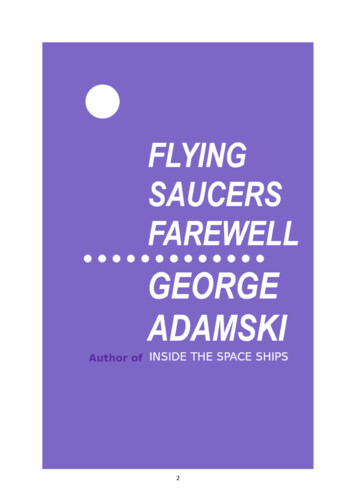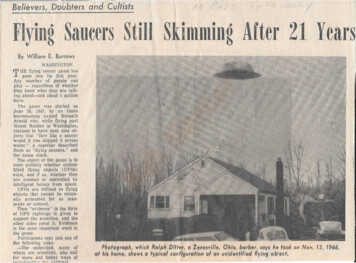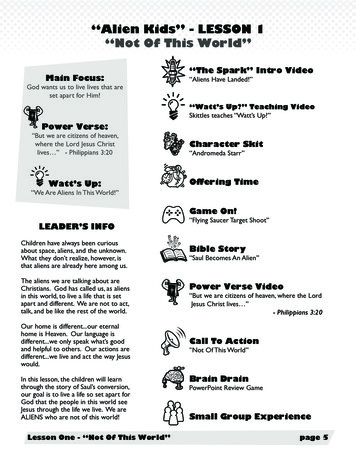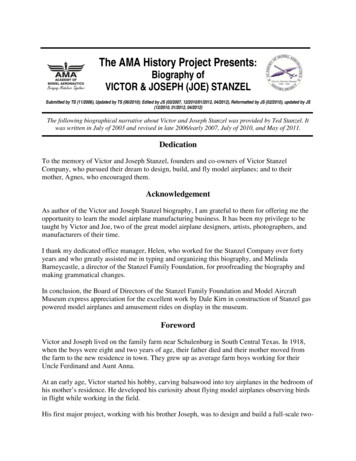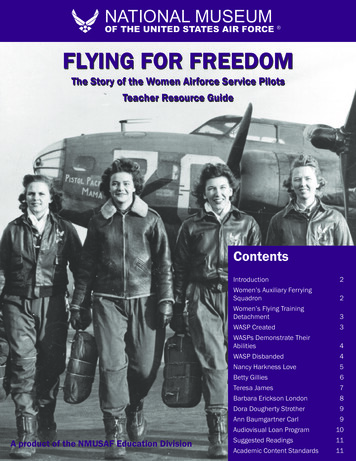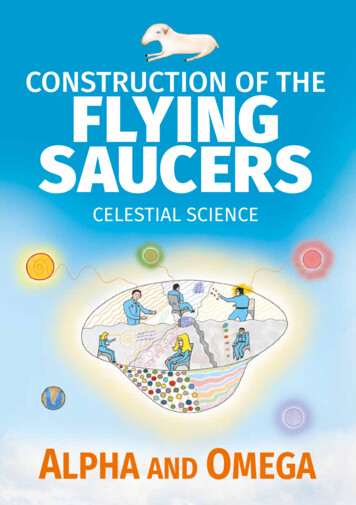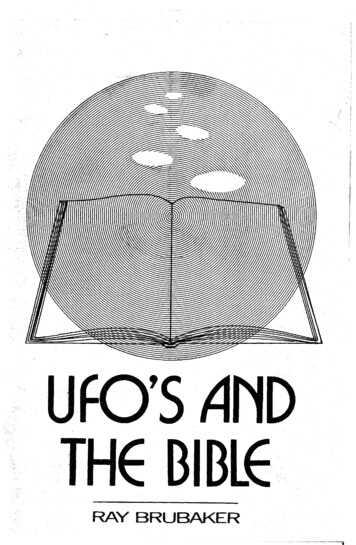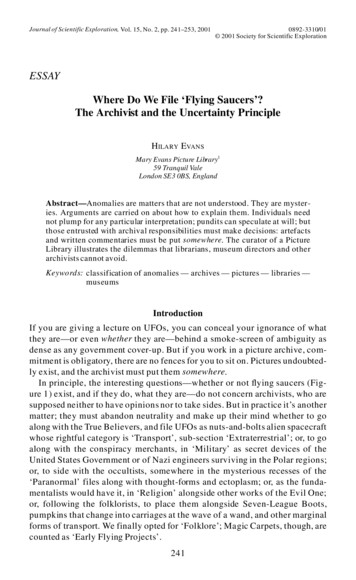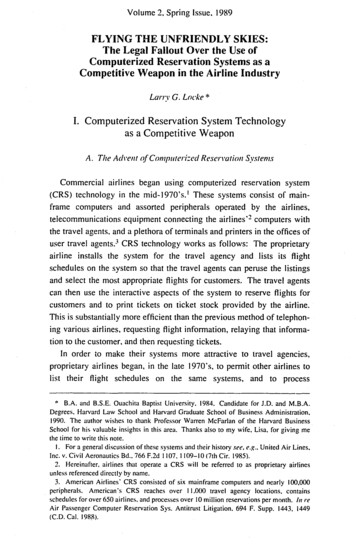
Transcription
V o l u m e 2, Spring Issue, 1989FLYING THE UNFRIENDLY SKIES:The Legal Fallout Over the Use ofComputerized Reservation Systems as aCompetitive Weapon in the Airline IndustryLarry G. Locke *I. Computerized Reservation System Technologyas a Competitive WeaponA. The Advent o f Compttterized Reservation SystemsC o m m e r c i a l airlines began using computerized reservation system(CRS) technology in the m i d - 1 9 7 0 ' s , t These systems consist of mainframe computers and assorted peripherals operated by the airlines,telecommunications e q u i p m e n t connecting the airlines '2 computers withthe travel agents, and a plethora o f terminals and printers in the offices o fuser travel agents. - C R S technology works as follows: The proprietaryairline installs the system for the travel agency and lists its flightschedules on the system so that the travel agents can peruse the listingsand select the most appropriate flights for customers. The travel agentscan then use the interactive aspects o f the system to reserve flights forcustomers and to print tickets on ticket stock provided by the airline.This is substantially more efficient than the previous method o f telephoning various airlines, requesting flight information, relaying that information to the customer, and then requesting tickets.In order to make their systems more attractive to travel agencies,proprietary airlines began, in the late 1970's, to permit other airlines tolist theirflight schedulesonthesamesystems,andtoprocess' B.A. and B.S.E. Ouachita Baptist University. 1984. Candidate for J.D. and M.B.A.Degrees, Harvard Law School and Harvard Graduate School of Business Administration.1990. The author wishes to thank Professor Warren McFarlan of the Harvard BusinessSchool for his valuable insights in this area. Thanks also to my wife, Lisa. for giving methe time to write this note.I. For a general discussion of these systems and their history see, e.g., United Air Lines,Inc. v. Civil Aeronautics Bd., 766 F.2d 1107, 1109-10 (7th Cir. 1985).2. Hereinafter. airlines that operate a CRS will be referred to as proprietary airlinesunless referenced directly by name.3. American Airlines" CRS consisted of six mainframe computers and nearly 100,000peripherals. American's CRS reaches over II,000 travel agency locations, containsschedules for over 650 airlines, and processes over 10 million reservations per month. In reAir Passenger Computer Reservation Sys. Antitrust Litigation. 694 F. Supp. 1443, 1449(C.D. Cal. 198.8).
220Harvard Journal of Law & Te 'hm h gyI Vol. 2reservations and ticket sales just as proprietary airlines did. 4 Thisenhanced the systems" appeal to travel agents by eliminating the need toconsult other information sources, This service originally was providedfree to subscriber airlines, while travel agents paid a fee to proprietaryairlines for equipment rental and other services provided. -sUnited Air Lines and American Airlines, which led the industry in thedevelopment of CRS technology, each spent over SI00 million todevelop their respective systems. 6 This level of investment put Americanand United at a competitive advantage because smaller airlines lackedthe financial resources to enter the CRS business. 7 In addition to the highcost of implementing a CRS, the Civil Aeronautics Board (CAB) notedthat a scarcity of technical expertise in this area created an additionalbarrier to entry. ' These and other barriers to entry gave proprietary airlines opportunities to exploit subscriber airlines and reap significantmarket advantages by manipulating both the presentation of the data andthe data itself. ';CRS technology has had a dramatic economic impact on the airlineindustry. This note discusses legal attempts to control this impact--firstwith a regulatory scheme, and, more recently, with an industry-wideantitrust suit. The disposition of legal issues raised by CRS technologywill have repercussions for a wide array of information technologyapplications.B. Tile Impact of CRSBy 1981, CRS technology had become a standard tool of travelagents, with an estimated 68 percent of all travel agencies in the UnitedStates automated, that is, using one or more CRS's. t Those agencies notautomated were typically smaller and less centrally located. In 1983, the4. Hereinafter. those airlines that list their flights on a proprietary, airlines" CRS will bereferred to as subscriber airlines.5. See. e.g. Air Passenger. 694 F. Supp. at 1450.6. American claimed to have spent SI60 million on its CRS. the SABRE system. SeeAlleged Competitive Abuses and Consumer Injury. 48 Fed. Reg. 41.171. at 41.173 (1983)[hereinafter Competitive Abusesl.7. hi. The Civil Aeronautics Board also noted that even if another operator were able toobtain the funding necessary to establish a competing CRS. it would not be a competitiveproduct without the participation of United and American in the new system.8. It .9. hL at 41.173-174. See also i 'a notes 16-34 and accompanying text.10. Lottis Harris Stt dy. TRAVEL WEEKLY. May 1982. at 46.
Spring, 1989]Flying the Unfriendly Skies221CAB estimated that the level of automation had increased to 80 percent IIand that the systems operated by United Air Lines and American Airlines dominated the industry, jointly accounting for 80 percent of all I automated agency locations.- The CAB further estimated that these twosystems accounted for 40 to 50 percent of all travel agency sales,representing a full 20 percent of total domestic travel, t-t Regional markets contained even higher concentrations. For example, in the Denverarea, 80 percent of bookings were processed through the United CRS, t4As of 1985, C R S ' s produced 57 percent of the airline industry's ticketrevenues, t5 From its development in the mid-1970"s, CRS rapidly grewto become the major conduit for the flow of information and revenues inthe domestic travel industry.CRS technology created more than just enhanced technical efficiencyfor travel agentsand airlines.It also created opportunities forproprietary airlines t o exploit the system as a competitive weapon.Because proprietary airlines had control over the format o f flightschedules, they could arrange that format so as to bias agents' bookings.Proprietary airlines established criteria for arrangement such that theirflights were listed at the top of the first screen of information to appear inresponse to an agent's query, while the toughest competitors" flightswere listed at the bottom of the last screen. 16 This "'screen bias," as itcame to be known, had a considerable effect on agents" bookings andcreated a significant advantage for the proprietary airlines 17In the late 1970"s, proprietary airlines began to permit subscriber airlines to avoid some of the screen bias by paying for "cohost" status onthe CRS. 18 A cohost's flights would be displayed in a preferred way inexchange for a fee paid to the proprietary airline for each booking on thecohost made via the CRS.Increasingly secure in their position,proprietary airlines in 1981 began to raise their booking fees to cohosts11. Compet#iveAbuses. supra note 6. at 41.175.12. Id.13. Id.14. Id.15. United Air Lines. 766 F.2d at 1110.16. Each s-,een held approximatelyeight flights. Id at I 110.17. Id. ("Besides the direct charges levied on travel agents and other airlines, airlinesthat own computerized reservation systems derive substantial revenue from the additionalairline business that they get from 'biasing' the system, that is. displaying flight information in a way that favors their own flights.").18. E.g.AirPassenger. 694 F. Supp. at 1450.
IIm'vard./mo'md ql'Lau' & 7'echnoh,gy222[Vol, 2f r o m 25 c e n t s p e r I ooking 1o as m u c h as t h r e e dolhu's p e r I lltlking, I' Even if II sul)seriher :lirlhl were willing Io pay Ibl' ohosl slllltlS, itstill nlighl be sultiecled Ill allli-eOlllpl'lilive la li s, Sonic subscTiher llh'lilies Iillegetl, for eXalllple, Ihal prl pril liu'y iiirlhles inlcnlioililllyIrlinsnlilled false infllrlnillilln iiblllil Ih ir Ililhls over IIIc (7111SI- ii l,]xiullpies of inisinfornliiliOll hlehicled " rl'on lltis hifilrnlillion iil'llltil seal availlibilily, chl, illl lligllls whidl Iwerel IIOI fully boiiked iilld iiJlowhlg ag lilSIo I'lllOk Sl-'illS till llighls Ihiil Iwerel lilready Iilled, ''21 Suhscribers alsoall t cl Ihill proprielary ,'iirlines o llsionally lransnlilled tlispiiriighi liIl SS;l OS ill'it/ill Sllbscribl r llirlines' llighls .llld l; nsor ll lillenlpls I0 s 11 1Collnl r-iil SSllg S, 22Prol'Jrielliry ail'lhles also llSed its il etlnlp liliV Iool title of Ihe illtlSlvahllibl prodtlclS of CRS I hnololy--lh Iiln ly iiviiillibilily ofnliirkel-sh,'ire thila for all Iriiv l agenls lind lih'lhles tl, ;hlg lh sySl lll,While propri liiry ah'lines h,'id iiccess I0 precise inforlniillon regiu'dhlgthe bookings of all Ilighi sl-'glllenls by ;i h agenl till all ilirlhles ill Ih sysl in, Ih only infornlaliOll provklcd Io iich stlbscriber liirlille wits iinlonlhly reporl of Ihlil airlili 's own bookhlgs. - 3 This uneqiiill ilccess IOnliirkc'l-shar dalli mid Ih Irends siich d;llii rev ,'ilcd gave propl'ieliiry ilirIhles il onsiderllble ',ldvalllage when COBI.II.ICIilII nl,'lrkclhlg o r pleotlll lllhlllllillg. 24Proprielary airlines also 11otlnd iheinselvcs ill an excel!enl posilion Ioexploil sensitive olnp iilor hllbrnl;ilion, Bcc,'ltlS proprietary airlineswere re;;ponsibl for updlllhlg subscriber airlines' tlighl scht:duh;s, Iheyh:ld advance noli of how and when Iheir onlpelilion Wotlld change i.lproducl Ihlc. -''s "Fills allowed proprietary airlines Io adjusl Illeir own conlpelitive prol.lticl slr:ilely prior io posihlg subscribers' adjtisllnenls on IIlesyslenl, lhus pr nlplhl I subscriber airlines' Illarkt;Ihlg inhi,'liiVeS, - 6This onlpelilive hlformalion was nol available IO subscriber airlines,T h e s e k i n d s o f b i a s e s d e c r e a s e d t h e vah.le Of C R S ' s to travel a g e n t s ,19.hi.20. Coml etitil'eAhuse. ',supra nole 6. a141.172.2 I.22.23.24.4hi.hi,Id.hL25. hi.26. hi. ("Conlinenlal alleged. , lhLiI American had delayed loading a new Itiw fiir unlilafter its marketing depm'lmenl had considered a cornpelilive response. American ckfimedIhIiI Ihc delay was necessary It avoid confu. ion and IhLll it,s policies lu,v Ix eolrevised."L.,H .-7
Spring, 1989]Flying the Unfriendly Skies223who were trying to provide objective information to their customers. 27To keep travel agents from switching to other CRS's, proprietary airlinesemployed various incentives, positive and negative, to attract and retainagent users. One approach was the inclusion of a minimum usecovenant by proprietary airlines in their contracts with travel agents. 28United Air Lines' CRS contract included a clause requiring that 95 percent of the tickets booked by the agent that contained at least one segment on United must be booked via United's Apollo system. 29 The confessed purpose of this clause was to force travel agents using Apollo toutilize that system exclusively, rather than maintaining multiple systems. 3 Proprietary airlines enforced these clauses by retaining the rightto examine the agents' books without notice. 31Proprietary airlines also employed positive incentives, such as offering substantial cash payments to agents willing to switch to their systems. 32 One industry periodical claimed that United Air Lines not onlyagreed to provide its Apollo system free of charge but also offered someagencies as much as 500,000 to switch from a competing system. 33Even the general business press took notice of these princely sumsoffered for travel agent favor. 34By the early 1980's, both subscriber airlines and travel agents27. BiNs. Dealerships' Top Cam'erns. TRAVEL AGENT, October 1 I. 1982. at 94.28. Competitive Abuses, supra note 6, at 4 I, 173.29. Id.30. United Issues Pac'ts Far Apollo Use With 95% E.rchtsivity Rule, TRAVEL WEEKLY,Nov. 15. 1982, at 1.Apparently. the clause is quite effective. American uses a similar clause in the contractsfor its system, with the result that 90 percent of the travel agents using American's SABREsystem t,se only that CRS. Ah" Passenger. 694 F. Supp. at 1458.Another reason for disallowing or discouraging agents from maintaining multiple systemsis that doing so better allowed the proprietary airline to keep track of the percentage of totalflights that were booked on its airline. Travel agents who did not give the proprietary airline a proportion of the business at least corresponding to their market share in the areawere subject to pressure from the airline to change their ways. "'Agents are also becomingaccustomed to receiving printouts of their reservation histories with little comments, sometimes nasty ones at that. asking why some other carrier was used instead of them." J. B.Seales, HE'S anly d tool--YOU'RE still the salesman. TRAVEL AGENT. Oct. 11, 1982. at19,3 I. United Issues Pacts For Apolla Use With 95% E.rchtsivity Rule. TRAVEL WEEKLY,Nov. 15. 1982. at 1.32. New Reservatioos Ahottt Airline Computers. THE FREQUENT FLYER, Dec., 1982,at 45--46.33. Id.34. How Airliltes Deal With Theh" Computers, BUSINESS WEEK, Aug. 23, 1982, at 68.("To compete. United this spring began offering what one agent calls "convenience money'as well as bonuses on increases in United sales, contract buy-outs, and free installation totempt agencies . . . . "').
224Harvard Journal o f Lan' & Technology[Vol. 2realized that CRS technology had changed the nature of competition inthe airline business. 35 Unable to combat the power of the proprietary airlines in the marketplace, these groups turned to the legal system forrelief.C. Regulatot 3' Responses to CRSComplaints from disadvantaged groups such as subscriber airlinesand travel agents eventually reached Congress, which ordered an investigation into the use of CRS technology as a means of unfair competition. 36 As a result, in 1982, both the CAB and the Antitrust Division ofthe Department of Justice (DO J) instituted investigations of the technology. The DOJ decided not to file suit despite finding that the airl,nes useCRS to weaken competition.37 The CAB, however, determined thataction was necessary and issued an Advanced Notice of ProposedRuiemaking in September 1983 prohibiting, inter alia, the conditioningof access to a CRS on the purchase of other services, the preferentialordering by carrier of flight information, and the use of discriminatorypricing. 3sThe C A B ' s proposed rules required that proprietary airlines justifydifferencesin feescorresponding costchargedsubscriber airlines by demonstratingvariations.39 TheDOJsuggestedadifferentapproach, urging that CRS services be provided to subscribing airlinesfree of charge. 4 This "zero fee" proposal was intended to provide asimpler, less intrusive system that would offset the price insensitivity ofsubscriber airlines with the price sensitivity of travel agents. 4 Subscriberairlines had shown little sensitivity to increases in cohost status price,rationally preferring to remain on the system rather than sever their35. The Associationof Retail Travel Agents and twelve subscriberairlines filed petitions with the CAB seeking rules to prohibit "'abuses" by CRS operators. CompetitiveAhuses. stq ra note 6.36. UnitedAir Lines, 766 F.2d at I 110.37. Carrier-Owned Computer Reservation Systems. 49 Fed. Reg. 32,540, at 32.543(1984) (codifiedat 14 C.F.R. § 255 (1988)).38. The CAB issued its final rules on July 27, 1984. Uni tedAir Lines, whose own CRSheld 27 percent (by revenue) of the travel agent market, challenged the rules as beingbeyond the authorityof the CAB becausethe CAB had held no evidentiaryhearings. JudgePosner. writing for the Seventh Circuit. ruled that under the CAB's authority to regulate"'deceptive"practices. "'the [CABI proceedingclearly was adequate, and we uphold the rulewithout hesitation.'"United Air Lira's, 766 F.2d at 1112.39. Carrier-OwnedComputer ReservationSystems.sttprlt note 37. at 32,543.40. Ill. at 32.552.41. Ill. at 32,552-553.
Spring, 1989]Flying the Unfriendly Skies225access to 80 percent of all travel agents. 42 Travel agents generally hadproven to be more price-sensitive consumers of CRS's and thereforewere capable of engendering competition among suppliers. 43 The DOJ'sproposal would have taken advantage of lhis characteristic of the markets by forcing proprietary airlines to derive all their CRS fees from themore price-sensitive travel agents. 44The CAB, however, rejected the zero fee proposal, observing thatsuch a rule would unfairly favor subscriber airlines by allowing them toreceive the benefits of CRS's without having to bear any of the costs ofthe systems. 45 Moreover, the CAB contended that price sensitivity mightvary among travel agents themselves. 46 The CAB noted that in somesparsely travelled regions, where only a few airlines provide service,travel agents may have such limited choice that price is not a primaryfactor. 47 The CAB concluded that subscriber airlines should continue topay for participation in the CRS's.The CAB declined to regulate another dis ' "iminatory practice,proprietary airlines' attempts to print all multiple-carrier flight ticketsonly on their own ticket stock. 4s While a ticketing airline may be the carrier for only part of the flight, it is entitled to hold the entire fare until thepassenger's travel is completed. Only then are the other carriers paid.This practice provides proprietary airlines with a substantial source ofshort-term cash. 49 The CAB reasoned that proprietary airlines have atleast an equal claim to being ticketing carders and that, as a practicalmatter, the current practice is not objectionable. 5 A mitigating factorwas that, for half the tickets generated on American's SABRE system,for example, travel agents overrode the program default that automatically named American the ticketing carrier. 51The CAB did, however, attempt to eliminate screen bias, ruling thatproprietary airlines could not use the identity of the airline as a criterionfor determining the order in which flights were to be listed on the42.43.44.45.46.47.48.49.50.51.note 6, at 41,176.Carrier-OwnedComputer Reservation Systems.st ora note 37, at 32.553.ld. at 32,552.hL at 32.553.Competitive Abuses. supraId.Id.Id.Id.Id.hi.at 32.551.
226Harvard Journal of Law & Technology[Vol' 2screen. 52 The CAB ruled that other criteria must be applied objectivelyand consistently for all carders and across all markets. 53 Consistencywas important to protect regional subscribers from proprietary airlines't a i l o r i n g their criteria to each local market. 54 Suppliers also wererequired to make screen arrangement criteria public in order to makepolicing of compliance easier. 55These rules, developed at the request of the subscriber airlines, provided a benefit to the proprietary airlines by allowing them to abrogateexisting contracts and execute new ones at higher prices. 56 Contractsbetween proprietary airlines and subscribers that conflicted with theC A B ' s new regulations were made void as of the date of the rules. 57United, faced with a system operating on the basis of voided contracts,notified its subscribers, including Republic Airlines, that CRS xecuted. 58Republic's contract accordingly was cancelled and Republic was offereda new subscription contract with higher fees. Republic, which had generated a quarter of its business through United's system, signed theunfavorable contract under duress and filed suit. 59 Justice Scalia, writingfor the D.C. Circuit, affirmed the lower court's judgment in favor ofUnited, holding that the old contract violated the newly issued rulesagainst arbitrary display preference and discriminatory pricing. 6 In aseparate suit, Republic attempted to evade the higher-priced contract bydirectly challenging the new CAB regulations. This suit also was unsuccessful. 6tIn spite of these attempts to regulate the use of CRS's, subscriber air-52. ld. at 32,550.53. ld.54. ld.55. Carrier-OwnedComputer Reservation Systems, 49 Fed. Reg. 35,507, at 35,508(1984) (codifiedat 14 C.F.R. § 255 (1988)).The CAB also required that proprietary airlines regularly update subscriber schedules.Late posting of changes confusestravel agents, could deter them from using subscriberairlines, and gives proprietary airlines opportunitiesto respond competitivelyto subscribers"actions before they take effect. Carrier-OwnedComputer ReservationSystems, supra note37, at 32,55I.56. Carrier-OwnedComputerReservationSystems,supra note 37, at 32,556.57. ld. See also supra note 37 and accompanyingtext.58. See Republic Airlines,Inc. v. United Air Lines, Inc., 796 F.2d 526, 528 (D.C. Cir.1986).59. ld.60. Id. at 529-30.61. United Air Lhles, 766 F.2d 1107.
Spring, 1989]Flying the Unfriendly Skies227lines filed an antitrust suit, - p o r t i o n s o f w h i c h are still p e n d i n g .Theplaintiffs, several regional airlines, c l a i m e d that the d e f e n d a n t s , A m e r i can A i r l i n e s a n d U n i t e d A i r Lines, were m o n o p o l i z i n g the air t r a n s p o r t a tion a n d airline r e s e r v a t i o n m a r k e t s t h r o u g h the use o f t h e i r r e s p e c t i v eC R S ' s . 63tII. The Antitrust LitigationA. Plaint ffT ClaimsPlaintiffs allegedthat d e f e n d a n t s v i o l a t e d the S h e r m a nAntitrustAct, 64 a n d a d v a n c e d three t h e o r i e s o f recovery. T h e first theory was thatd e f e n d a n t s " C R S ' s are essential facilities for the d i s t r i b u t i o n o f air travela n d thus s h o u l d be c o n t r o l l e d by the essential facilities doctrine. 65 T h es e c o n d theory applied the c o n c e p t o f m o n o p o l y l e v e r a g i n g , c h a r a c t e r i z ing d e f e n d a n t s " use o f C R S t e c h n o l o g y as an a t t e m p t to l e v e r a g e t h e i rm o n o p o l y in the C R S m a r k e t to gain u n f a i r a d v a n t a g e in air t r a n s p o r t a tion m a r k e t s . 66 T h e third theory was that d e f e n d a n t s h a d m o n o p o l i z e d , orwere a t t e m p t i n g to m o n o p o l i z e , national a n d local air t r a n s p o r t a t i o nm a r k e t s and the various m a r k e t s for C R S service, h o w e v e r they aredefined. T h e parties filed cross m o t i o n s for s u m m a r y j u d g m e n t o n theseclaims. 6762. Air Passenger. 694 F. Supp. 1443.63. The plaintiffs are: Continental Air Lines, Inc.; Texas International Airlines, Inc.;New York Airlines, Inc.; USAIR. Inc.: Pacific Southwest Airlines, Inc.; Aircal, Inc.; OzarkAir Lines. Inc.: Muse Air Corporation; Alaska Airlines, Inc.; Midway Airlines, Inc.;Northwest Airlines. Inc.: and Western Air Lines, Inc. American Airlines counterclaimed/ gainst all of the defendants except for Continental, Texas International. and New YorkAir. Id. at 1443.64. 15U.S.C.§§ 1-40(1982).65. Air Passenger, 694 F. Supp. at 1451.66. hL at 1472.67. On August 8, 1988. the Court heard the following cross motions for summary judgment:(1) Defendants moved for summary, judgment on plaintiffs' claim based on theessential facilities doctrine and Section 2 of the Sherman Act.(2) Defendants moved for summary judgment regarding the plaintiffs' claim thatdefendants are monopolizing or attempting to monopolize the CRS market and theSABRE/Apollo market.(3) Plaintiff Continental moved for summary judgment on its claim that defendant American exercised monopoly power.(4-6 & 8) Defendants moved for summary judgment on various claims thatdefendants had monopolized certain local CRS markets, the national air transportation market, and certain local air transportation markets.(7) Defendant United moved for summary judgment on plaintiffs" claim thatUnited monopolized the national CRS market.
228Harvard Journal of Law & Technology[Vol. 2The essential facilities doctrine historically has been applied to situations where a c o m p e t i t o r ' s control of a distribution channel has resultedin that competitor having an unfair competitive advantage in an underlying market. 6x The essential facilities doctrine was e m p l o y e d successfullyby MCI C o m m u n i c a t i o n s to gain access to A m e r i c a n T e l e p h o n e andTelegraph C o m p a n y ' s local telephone lines in order to c o m p e t e in longdistance service/'9 The purpose of the doctrine is to preve it a competitorfrom achieving a m o n o p o l i s t ' s position in a market by virtue of its control o v e r a facility that other competitors must use in order to c o m p e t e inthat market. TM Courts will use the essential facilities doc;rine to force theparty controlling the essential facility to provide its competitors with reasonable access to it. 7jThe court in A i r P a s s e n g e r decided that, as a matter o f law, defendants had not violated antitrust law under the essential facilities doctrine.The court held that a reasonable jury could not find any danger thatdefendants' C R S ' s enabled them to m o n o p o l i z e the underlying air transportation market. T h e court reasoned that c o m p e t i n g C R S ' s w o u l dprevent such monopolization, and that defendants' market share wassmall enough that a claim o f m o n o p o l y p o w e r in this market was"absurd. "'7- The court a c k n o w l e d g e d that significant barriers to entryexist for any c o m p e t i n g C R S but relied on the theory, proffered by JudgePosner in U n i t e d A i r Lines, that market forces will rectify any e c o n o m i cimbalance in the air transportation market. 73H a v i n g found that there was no danger o f m o n o p o l y in the nationalair transportationmarket,the court disposed both o f the claim o f19) Defendants moved for summa judgment on plaintiffs" monopoly leveraging theory.(10) Defendant United moved for summary judgment on plaintiffs" claim fortravel agent conspiracy.hi. at 1475.68. hi. at 1451.69. MCI Communications Corp. v. American Tel. & Tel. Co. 708 F.2d 1081. 1133 ('TthCir.). t't'rL dt'oit'd. 464 U.S. 891 (1983).70. Air Passcnger, 694 F. Supp. at 1451. The facility need not be indispensable but itsdenial must impose a severe handicap on other potential competitors. See also Hecht v.Pro-Football, Inc. 570 F.2d 982 (D.C. Cir. 1977). t'erL denied. 436 U.S. 956 (1978): seegcm'rally W. HOLMES.ANTITRUSTLAW HANDBOOK§ 2.06 (1987),71. Air Passen. cr. 694 F. Supp. at 1451.72. hi. at 1456. ("American has never had more than a 14 percent share of the air transportation market . . . . A claim lhat a twelve to fourteen percent market share confersmonopoly power is absurd, absent a showing that the air transportation market is characterized by a low elasticity of demand or supply.").73. hL at 1453.
Spring, 1989]monopolyFlying the Unfriendly Skieso f that m a r k e t , 74 a n dof the claims229basedonmonopolyl e v e r a g i n g in t h a t m a r k e t . 75 W i t h o n e e x c e p t i o n that d i d n o t rely s o l e l yon the use of CRS's,defendants" motions for summary judgmentwithregardof monopolizationwereto t h e c l a i m so f localmarketsalsog r a n t e d . 7 ' T h e c o u r t f o u n d that p l a i n t i f f s h a d n o t p r e s e n t e d a n y e v i d e n c et h a t t h e a i r t r a n s p o r t a t i o n a n d C R S m a r k e t s w e r e a n y t h i n g b u t n a t i o n a l ins c o p e , a n d h e n c e , local m a r k e t s w e r e n o t r e l e v a n t m a r k e t s l b r a n t i t r u s tp u r p o s e s . 77B. PlaintifJT Surviving ClaimsThe only significant claims surviving summary judgment in AirPassenger were those based on allegations that proprietary airlinesmonopolized or attempted to monopolize the national CRS market, orthe respective SABRE and Apollo CRS markets, or both. To succeed onthe monopoly claim, plaintiffs must show, inter alia, that the defendantshave monopoly power in a relevant market. TM Similarly, to succeed onthe attempted monopoly claim, plaintiffs must show that defendants hada specific intent to monopolize a relevant market. 79 Both the monopoly74. Id. at 1455-56. 1466--67.75. Id. at 1474-75. The court went further and rejected the monopoly levemging theoryitself. The court reasoned that to the extent that monopoly leveraging is not coextensivewith monopoly and attempted monopoly, it is inconsistent with the requirements of theSherman Antitrust Act.76. See il!l'ra note 79 and accompanying text.77. Air Passenger. 694 F. Supp. at 1467.78. ld. at 1460. ("The elements of monopolization under section 2 of the Sherman Actare (1)possession of monopoly power in a relevant market: (2) wilful acquisition ormaintenance ('use') of that power: and (3)causal antitrust injury." (citing Catlin v. Washington Energy Co., 791 F.2d 1343. 1347 (9th Cir. 1986))).79. The Ninth Circuit Court of Appeals does not require a showing of a relevant marketif specific intent to monopolize is demonstrated. See Air Passenger, 694 F. Supp. at 1468.Lacking a showing of specific intent, the court in Ah" Passenger found that the national.rather than the local markets, were relevant. Plaintiffs" numerous claims of monopoly andattempted monopoly of local air transportation and local CRS markets all (ailed on summary judgment, with the exception of their claim concerning the local Dallas/Ft. Worth airtransportation market. The court found that specific intent to monopolize on the part ofAmerican Airlines was shown by the following telephone exchange between American'spresident. Robert Crandall. and Braniff's president, Howard Putman. regarding flights fromDallas/Ft. Worth:Putman: Do you have a suggestion for me?Crandall: Yes. I have a suggestion for you. Raise your goddamn fares twenty percent. I'll raise mine the next morning . . . . We can both live here and there ain't noroom for Delta. But there's, ah. no reason that I can see. all right, to put both companies out of business.hi. at 1469.
Harvard Journal of Law & Technol
7. hi. The Civil Aeronautics Board also noted that even if another operator were able to obtain the funding necessary to establish a competing CRS. it would not be a competitive product without the participation of United and

